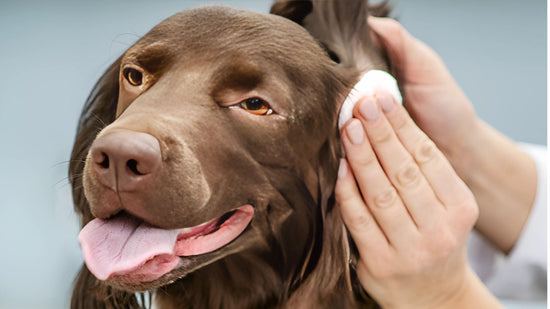If your dog is suffering from a yeast infection, you may be looking for natural ways to help treat it at home. Yeast infections in dogs are quite common, especially in areas that are moist and warm, such as the ears, paws, and skin folds. Thankfully, there are several home remedies that can help manage and treat dog yeast infections effectively. In this article, we’ll explore some of the best home remedies for treating dog yeast infections, including the use of probiotics for dogs an important element in supporting your dog’s immune health and restoring balance to their system.

What Causes Yeast Infections in Dogs?
Yeast infections in dogs are often caused by an overgrowth of Malassezia pachydermatis, a yeast that is naturally present on your dog’s skin. Under normal circumstances, yeast exists in small amounts, but factors like allergies, poor hygiene, an underlying health condition, or a weakened immune system can cause the yeast to multiply excessively.
How to Recognize a Yeast Infection in Your Dog
A yeast infection in dogs can show up in a variety of ways, depending on the area affected. Some common symptoms include:
- Itching and Scratching: Dogs with yeast infections will often scratch or bite the affected area.
- Redness and Inflammation: The skin may become red and inflamed, especially in skin folds or on the ears.
- Odour: Yeast infections often cause a strong, musty smell.
- Discharge: A dog with a yeast infection in their ears may have a brown or yellow discharge.
- Hair Loss: Excessive licking and scratching may lead to hair loss in the affected areas.
Home Remedies to Treat Dog Yeast Infection at Home
There are several home remedies that can help treat yeast infections in dogs. While they may not provide a complete cure, these treatments can help reduce symptoms and provide relief for your dog.
1. Apple Cider Vinegar Solution
Apple cider vinegar is known for its antifungal properties, making it a great natural remedy for treating yeast infections. To make a solution:
- Mix equal parts of water and apple cider vinegar in a spray bottle.
- Spray the solution onto the affected areas, such as the paws, ears, or skin folds. Avoid spraying it directly into your dog’s eyes.
- Use this treatment 2-3 times a week to help soothe the skin and fight the yeast overgrowth.
2. Coconut Oil for Skin and Coat
Coconut oil is another effective remedy for yeast infections. It has antifungal properties that can help kill the yeast, while also soothing irritated skin. To use coconut oil:
- Apply a thin layer of organic coconut oil directly to the affected area.
- Gently rub it in and leave it to absorb into the skin.
- Repeat this 1-2 times a day until you see improvement.
3. Probiotics for Dogs
Probiotics play an important role in managing yeast infections. By promoting a healthy balance of good bacteria in your dog’s gut, probiotics can help prevent the overgrowth of yeast. Probiotics for dogs work by boosting the immune system and supporting healthy digestion.
One of the best ways to introduce probiotics to your dog’s diet is through a high-quality meal topper. Molly’s Meal Topper with Probiotics is specifically designed to promote gut health and balance, making it an ideal addition to your dog’s diet when managing a yeast infection.
Probiotics for dogs are particularly helpful when used alongside other treatments, as they support the body’s natural defense mechanisms and help prevent recurring yeast infections.
For a great probiotic option, try Molly’s Meal Topper with Probiotics. This topper is rich in beneficial probiotics that promote a healthy gut microbiome and aid in managing yeast infections from the inside out.
4. Bathe Your Dog with a Yeast Infection Shampoo
Regular baths are important when treating yeast infections in dogs. Use a gentle antifungal shampoo designed for dogs with yeast infections. These shampoos are formulated to kill yeast and relieve itching and discomfort. When bathing your dog:
- Wet your dog’s coat with warm water.
- Apply the antifungal shampoo and lather thoroughly, focusing on the affected areas.
- Leave the shampoo on for 5-10 minutes to allow it to work, then rinse thoroughly.
- Repeat the bath 2-3 times a week until symptoms improve.
5. Keep Your Dog Dry and Clean
Yeast thrives in warm, moist environments. Keeping your dog clean and dry is essential to preventing and treating yeast infections. After walks or baths, make sure to dry your dog’s ears, paws, and skin folds completely. You can also use a towel to gently pat the areas dry after any wet activity.
Additionally, if your dog has long hair, regular grooming and trimming of the coat around the affected areas can help prevent moisture buildup and reduce the chances of yeast overgrowth.
6. Dietary Adjustments
A healthy diet is essential for managing yeast infections. Foods high in sugar and refined carbohydrates can feed the yeast and make the infection worse. Consider adjusting your dog’s diet to one that is low in sugars and grains. High-quality, grain-free dog food with a focus on lean protein and vegetables can help support your dog’s immune system and reduce the risk of future yeast infections.
Nature’s Help Pet-Friendly Products offers a range of pet supplements, including options that can help promote overall health and support the immune system.
To explore Nature’s Help Pet-Friendly Products, visit Turmeric Australia’s Pet-Friendly Collection. These products are designed with your dog’s health in mind, offering holistic support to manage yeast infections and improve overall well-being.
When to See the Vet
While home remedies can help manage a yeast infection, it's important to consult your vet if the infection persists or worsens. Yeast infections can sometimes lead to secondary infections or be a sign of an underlying condition, such as allergies or immune system dysfunction.
Your vet can provide additional treatments, such as prescription antifungal medications or advice on how to better manage your dog’s diet and environment to prevent recurring yeast infections.
Conclusion
Yeast infections in dogs can be uncomfortable and frustrating, but with the right home remedies and products, you can help manage and treat the infection effectively. Using natural remedies like apple cider vinegar, coconut oil, and probiotics, along with keeping your dog clean and dry, can go a long way in providing relief. For a convenient and effective solution, consider adding Molly’s Meal Topper with Probiotics to your dog’s diet.
If you're looking for additional products that can support your dog’s health, explore Turmeric Australia’s Pet-Friendly Products. These products are designed to support immune function, improve gut health, and provide your dog with the nutrition they need to stay healthy.
By combining these home remedies with high-quality products, you can help your dog feel better and prevent future yeast infections from affecting their health.










